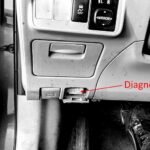A Heads-Up Display (HUD) paired with OBD2 and GPS technology can significantly improve your driving experience. By projecting crucial information directly onto your windshield, a Hud Obd2 Gps keeps your eyes on the road, enhancing safety and convenience. This article explores the benefits of this technology and explains how it works.
Understanding the Technology Behind HUD OBD2 GPS
A HUD OBD2 GPS system combines three key components:
Heads-Up Display (HUD)
The HUD is a transparent display that projects information onto the windshield, allowing drivers to view data without looking away from the road. This projection appears within the driver’s line of sight, minimizing distractions.
On-Board Diagnostics II (OBD2)
The OBD2 port, standard in most modern vehicles, provides access to real-time vehicle data. The HUD OBD2 GPS system connects to this port, extracting information like speed, RPM, engine temperature, and fuel consumption.
Global Positioning System (GPS)
The GPS component provides location data and enables features like navigation and speed limit warnings. Integrating GPS with the HUD allows for displaying turn-by-turn directions and real-time speed information relative to the speed limit.
Benefits of Using a HUD OBD2 GPS System
Investing in a HUD OBD2 GPS system offers numerous advantages:
Enhanced Safety
By keeping vital information within the driver’s field of vision, HUDs minimize the need to look down at the dashboard, reducing distractions and improving reaction time. This focus on the road enhances overall safety.
Improved Situational Awareness
The combination of vehicle data from OBD2 and location information from GPS provides a comprehensive view of driving conditions. Drivers can monitor vehicle performance and navigate effectively, increasing situational awareness.
Optimized Driving Experience
Features like speed limit warnings, navigation guidance, and real-time vehicle data contribute to a more informed and efficient driving experience. The convenience of having this information readily available allows for a smoother and more enjoyable journey.
Customizable Display
Many HUD OBD2 GPS systems allow users to customize the displayed information and adjust brightness levels to suit individual preferences and driving conditions. This personalization ensures optimal visibility and relevance of the projected data.
Choosing the Right HUD OBD2 GPS System
Consider these factors when selecting a HUD OBD2 GPS:
-
Display Size and Clarity: Opt for a display size that provides comfortable viewing without obstructing your view of the road. Ensure the projected image is clear and easily readable in various lighting conditions.
-
Compatibility: Verify compatibility with your vehicle’s OBD2 system. Check for any specific requirements or limitations based on your car’s make and model.
-
Features: Consider the features most important to you, such as navigation, speed limit warnings, and customizable display options.
-
Ease of Installation and Use: Choose a system that is easy to install and operate, with a user-friendly interface and intuitive controls.
Conclusion
A HUD OBD2 GPS system is a valuable investment for drivers seeking to enhance safety, convenience, and overall driving experience. By providing crucial information directly in the driver’s line of sight, this technology minimizes distractions, optimizes situational awareness, and contributes to a more enjoyable and efficient journey. Careful consideration of individual needs and preferences will guide you toward selecting the best HUD OBD2 GPS system for your vehicle.

